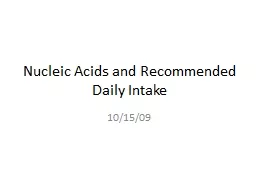

101509 Nucleic Acids Large complex organic molecules that store and transfer genetic information in the cell Two major types Deoxyribonucleic acid DNA and ribonucleic acid RNA DNA contains information that determines characteristics of an organism and directs its cell activities ID: 908005
Download Presentation The PPT/PDF document "Nucleic Acids and Recommended Daily Inta..." is the property of its rightful owner. Permission is granted to download and print the materials on this web site for personal, non-commercial use only, and to display it on your personal computer provided you do not modify the materials and that you retain all copyright notices contained in the materials. By downloading content from our website, you accept the terms of this agreement.
Slide1
Nucleic Acids and Recommended Daily Intake
10/15/09
Slide2Nucleic Acids
Large, complex organic molecules that store and transfer genetic information in the cell
Two major types: Deoxyribonucleic acid (DNA) and ribonucleic acid (RNA)
DNA contains information that determines characteristics of an organism and directs its cell activities
RNA stores and transfer information from DNA essential for manufacturing proteins.
Slide3Both RNA and DNA are polymers composed of monomers called nucleotides.
A nucleotide is made up of three components: phosphate group, a five-carbon sugar and a ring-shaped nitrogenous base.
phosphate group
deoxyribose (sugar)
nitrogen-containing
base
Spiral-shaped double helix
Slide4Contains at least one double bond
Contains only single bonds
Characteristics of a Lipid
Nonpolar
Do not dissolve in water
Contain fatty acids bonded to glycerol
Have a high number of C and H but few O atoms
Saturated Fat
Unsaturated Fat
Slide5Structure of a Fatty Acid
Nonpolar
Hydrocarbon chain
Carboxyl group
Nonpolar
Inside the cell
Polar
Outside the cell
Functions of a Lipid
Function of a Lipid
Broken down as a source of energy
Make up cell membranes
Used to make hormones
Slide6Broken down as a source of energy
Found primarily in fats (vegetable oil)
Liquids at room temperature
May lower cholesterol
Mainly from animal sources such as meat and dairy
Solid at room temperature
Results in high blood cholesterol
Polar phosphate head
Nonpolar fatty acid tail
Phospholipid
Waxes
Consists of one long fatty chain and an alcohol chain
Slide7Steroids
Four fused carbon rings with functional groups
Types of Lipids
Used to form a protective coating (waterproof)